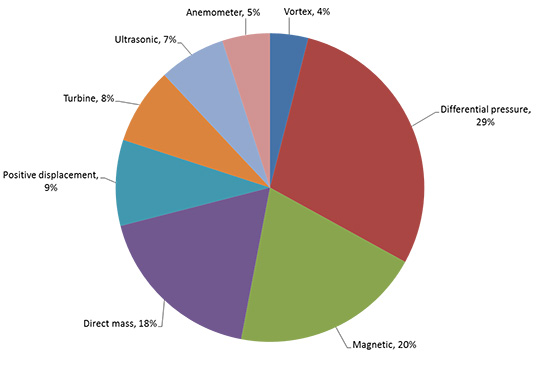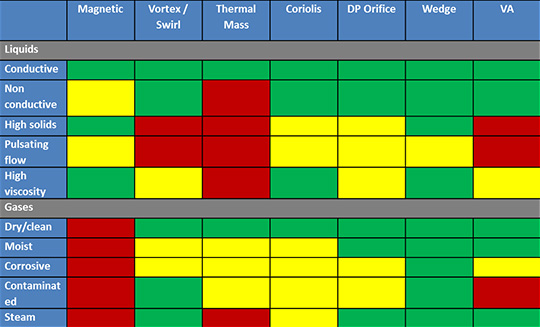How selecting the right flowmeter can help you minimise your annual energy costs

The extensive choice of flow technology options on offer can make selecting the correct flowmeter for an application a bewildering task. A broad range of factors can influence flowmeter selection, of which cost is just one.
Flowmeter technologies narrowing down the choice
The pie chart shown below indicates the variety of flowmeter technologies available and their representation in the processing industries.

Of the technologies shown, electromagnetic, vortex, turbine, ultrasonic, and anemometer, all actually measure the flow velocity of the fluid in the pipe. Multiplying the measured average velocity by the cross-sectional area of the meter or pipe will give the value for volumetric flow rates.
Flowmeters based on differential pressure orifice plates, nozzles, wedges, Venturis, and Pitot tubes introduce a restriction in the flow. The unrecoverable pressure loss caused by the restriction is a measure of the volumetric flow rate.
Positive displacement flowmeters are true volumetric flow devices, measuring the actual fluid volume that passes through a meter body with no concern for velocity. These flowmeters capture a specific volume of fluid and pass it to the outlet. The fluid pressure moves the mechanism that empties one chamber as another fills.
If the application requires a measure of the mass flow rate, volumetric flowmeters must be supplemented with additional information, such as fluid density, pressure, and/or temperature. Some multivariable flowmeters and transmitters incorporate an additional sensor to provide this information. On the other hand, Coriolis flowmeters (and thermal probes for gas) directly measure mass flow rate. With a current market share of around 18 percent, they are steadily finding their way into an increasing range of applications.
The table below shows the applicability of certain flowmeter technologies to various liquid and gas conditions. Green indicates the technology will generally work while red rules it out. Yellow indicates that the flowmeter technology may sometimes work provided that certain conditions are met. Obviously more than one technology can apply for a given set of fluid conditions.

Where this occurs, the next step in narrowing down the selection choice is to calculate which one is likely to be able to help you save the most energy.
Why minimize energy?
Many flowmeter technologies introduce pressure loss into a system. Pressure losses equate to energy losses and costs. Valves, pipe friction, reducers, expanders, and measuring devices such as flowmeters all increase the Permanent Pressure Loss (PPL) in the system.
Some flowmeters require upstream reducers and downstream expanders to operate properly.
For new processes, engineers often consider PPL when designing a system because it's important in sizing the pump (liquids), compressor (gases), or boiler (steam) to meet process conditions and to deliver the desired pressure and/or flow. For operating processes, PPL leads directly to the need for compensating energy, which can equate to significant increased annual operating costs. By minimizing pressure losses in a process, engineers can cut the need for top-up pumping or compression as well as environmental impact. In the case of steam boilers, which are expensive, the ability to retrofit existing flowmeters with those having low pressure losses can boost the effective boiler capacity.
By selecting flowmeters with low pressure losses, engineers can:
- Reduce pumping/compressing cost
- Increase capacity
- Minimize compressor, pump or boiler size.
The amount of pressure lost in a flowmeter depends on three factors: the fluid density, the square of the fluid velocity (Vf)2, and the degree of obstruction to fluid flow, (Kmeter). The following list roughly ranks the magnitude of the Kmeter factor for various flowmeters, from greatest pressure loss to lowest.
1. Coriolis
2. Orifice/Nozzle
3. Turbine
4. Vortex
5. Venturi
6. Averaging Pitot tube
7. Electromagnetic/Ultrasonic (negligible PPL)
Replacing an orifice plate with an averaging Pitot tube, for example, can reduce the permanent pressure loss (energy requirement) by a factor of 20. Averaging Pitot tubes offer minimal irrecoverable pressure losses as well as being inexpensive and simple to install.
Examples of energy usage
Calculation of energy usage per unit of time depends on the product of the permanent pressure loss (PPL) and the volumetric flow rate Q divided by the mechanical efficiency (ME) of the system in decimal.
Incorporating units of measurement, specifically make-up power in watts, PPL in inches of water, and Q in cubic feet per minute (CFM), the equation thus becomes Power = (0.118 PPL * Q) / ME. The system mechanical efficiency ME is the product of the decimal efficiencies of the electric motor and that of the pump or compressor. Boilers also have an associated system efficiency. The following analyses assume a system efficiency of 0.70 for nitrogen and water and 0.90 for the boiler. Lower system efficiencies obviously require more power to make up for the pressure losses in the process.
The annual cost can then be calculated by multiplying the energy by the local electricity cost (£/kwh) and the number of operating hours in a year (8,760 total hours per year). The examples below assume a cost / kilowatt hour of £0.16, which is close to the UK national average (in 2012). Actual costs will of course differ by residential, commercial, and industrial end uses.
Nitrogen, water, and steam serve as representative gases and liquids for a great many materials common to chemical plants. Below are calculations of the savings possible for an orifice, averaging Pitot, vortex, and magmeter (liquids only) flowmeters using these gases and fluids as examples.
Example 1. Nitrogen gas
4-inch line
Normal flow: 1500 SCFM
Pressure: 50 psig
Flow at 50 psig (64.7 psia) = 1500 / [64.7 / 14.7] = 341 CFM
ME: 70 percent
Technology PPL in H2O Power (Watts) 70% ME Watts Annual $ cost
Orifice 54 2173.8 3104 2719.10
Ave. Pitot 2.8 112.7 160 140.16
Vortex 27.2 1094.4 1563 1369.19
Orifice beta = 0.65 for all the examples
Example 2. Liquid water
4-inch line
Average flow: 26.74 CFM
ME: 70 percent
Technology PPL in H2O Power (Watts) 70% ME Watts Annual $ cost
Orifice 64.1 202.3 288 252.29
Ave. Pitot 7.5 23.7 33 28.91
Vortex 25.6 80.8 115 100.74
Magmeter 0 0 0 0
Example 3. Steam
4-inch line
Density = 0.1495 lbs per cubic foot = 6.68 cu ft/lb
Flow = 125 lbs/min * 6.68 cu ft/lb) = 835 CFM
Boiler efficiency: 90 percent
Technology PPL in H2O Power (Watts) 90% Eff Watts Annual $ cost
Orifice 83.7 8247 9163 8026.78
Ave. Pitot 5.23 515.3 572.6 501.60
Vortex 47.12 4643 5159 4519.28
Obviously a process system may have several flowmeters and other pressure reduction devices served by a pump, compressor, or boiler, leading to much higher costs than indicated here. However, even where this is the case, lowering the Permanent Pressure Loss can still make a significant contribution to helping lower electricity bills by minimising the pump and / or compressor size or work. Lowering PPL can also be a low-cost method of expanding steam boiler capacities.
Summary
With flowmeters normally being selected on their ability to provide accurate and reliable measurement, it can be easy to overlook the potential impact of the meter itself on the efficiency of a process line. With the competitiveness of UK industrial companies currently being hampered by high energy costs, any step that can be taken to minimise energy consumption could provide a valuable first step towards enhanced profitability.
As a leading manufacturer and supplier of almost every type of flowmeter, ABB has the expertise and resources to help you make the best choice of device for your application. For advice or for more information, please email moreinstrumentation@gb.abb.com or call 0870 600 6122.
Further Information:
Flow portal: http://new.abb.com/products/measurement-products/flow
Selector tool: http://www70.de.abb.com/flow_selection_advisor/gui/

| Telephone: | 01480 475321 |
| Email: | info@gb.abb.com |
| Website: | www.abb.co.uk/measurement |
| More information on the ABB Limited BVAA Member Directory Page |
Search related valve / actuator articles: ABB LimitedIssue 33Related ProductsFlow Meters











